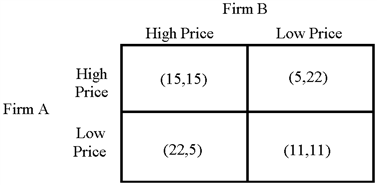Figure 13-4

The above matrix (Figure 13-4)displays the possible profit results of two firms, A and B, from following two different possible strategies: charging a high price and charging a low price. In each cell, the first number is the profit of firm A, and the second number is the profit of firm B.
a. Assume that collusion is not possible. Determine the optimal strategy for each firm. Explain why it is the best strategy to follow.
b. Based on your answer to a., explain why firms collude. What are the pitfalls of collusion?
Definitions:
Corporation
A legal entity that is separate from its owners, with the ability to own assets, incur liabilities, and conduct business.
Unlimited Liability
A legal structure in which the owners are personally liable for all the debts and liabilities of the business, without any limit.
General Partnership
A business arrangement where two or more individuals agree to share in all assets, profits, and financial and legal liabilities of a jointly-owned business.
Corporation
A legal entity created by individuals, stockholders, or shareholders, with the purpose of operating for profit. Corporations can enter contracts, sue and be sued, and pay taxes apart from their owners.
Q36: Rent-seeking behavior refers to<br>A)the offering of goods
Q41: A monopolist's profit per unit is shown
Q49: Imposing fines on companies that contribute heavily
Q54: There is much world concern over the
Q104: Society benefits from monopolistic competition because the
Q116: Price discrimination<br>A)may lead to greater output.<br>B)always leads
Q126: The environmental problems of China is not
Q137: Economists object to monopoly because<br>A)monopoly profits go
Q144: Global climate change will not<br>A)affect the migration
Q237: Give a complete and concise definition of